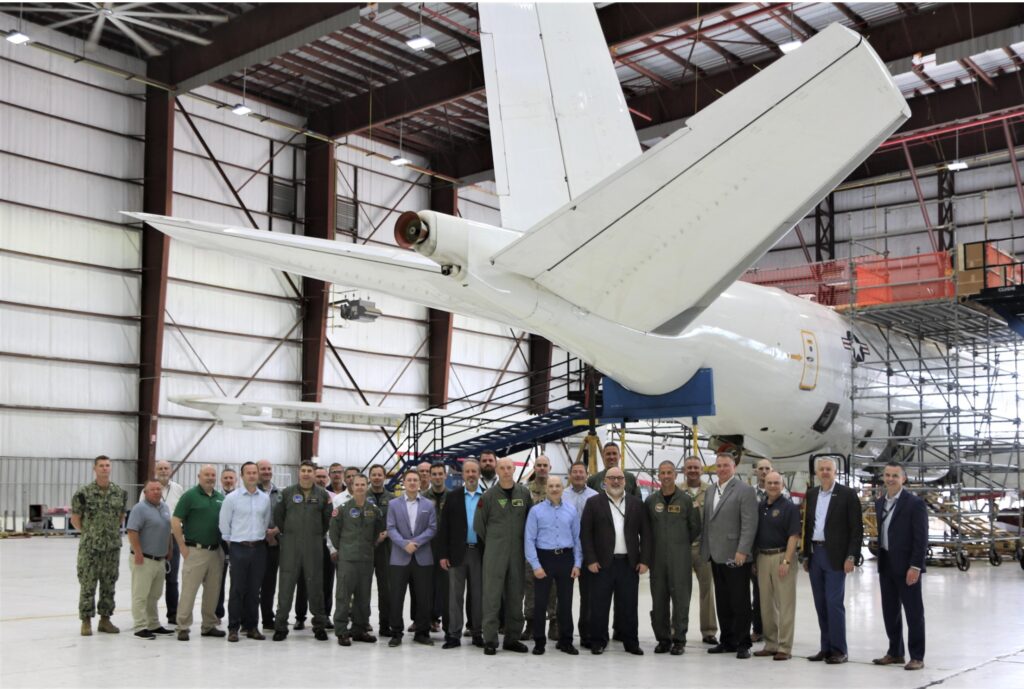
Release from Naval Air Systems Command
*****
Published: Jun 6, 2023
LAKE CHARLES, La. — The U.S. Navy this month accepted the first E-6B Mercury upgraded by Northrop Grumman Corp. in Lake Charles, delivering enhanced airborne strategic communication capabilities to the warfighter.
The upgrade supports the Navy’s nuclear deterrence mission, ensuring the president, secretary of defense and U.S. Strategic Command remain connected to the U.S. nuclear arsenal in a worst-case scenario.
Northrop Grumman Corp. conducted the upgrades over the last year at its Aircraft Maintenance and Fabrication Center at Lake Charles. Under its Integrated Maintenance and Modification Contract (IMMC) with the Navy, it will overhaul multiple E-6B Mercury aircraft by 2027. The $111 million contract provides six major modifications – called Block II – to improve the aircrafts’ command, control and communications functions connecting the National Command Authority with U.S. strategic and non-strategic forces.
Block II will ensure the E-6B can successfully execute their mission for years to come.
Upgrades to the second aircraft are already underway.
“The delivery of the first IMMC aircraft is a monumental achievement,” said Bob Stailey, the E-6B deputy program manager for the Airborne Strategic Command, Control, and Communications Program Office (PMA-271), which awarded and manages the maintenance contract. “We are delivering enhanced capabilities to the fleet quicker and ensuring they have the tools to successfully execute this critical mission for years to come.”
Working with the Navy, Northrop Grumman is getting closer to the contract’s required turnaround time of six months by implementing process improvements that span engineering, scheduling, management and production. This is the first time a single company is responsible for the entire installation, reducing bureaucracy and improving speed.
“An incredible amount of work went into this aircraft, which can now perform its nuclear deterrence mission better than ever.” said Capt. Adam Scott, PMA-271 program manager. “During the past year, the team that fielded this capability worked tirelessly to implement improvements to deliver the Block II capability with urgency.”
Pilots from Strategic Communications Wing One (SCW-1) picked up the plane on June 6 and flew it home to Tinker Air Force Base, Oklahoma.
The E-6B Mercury is a communications relay and strategic airborne command post aircraft. It executes the Take Charge and Move Out (TACAMO) mission, connecting the president and secretary of defense with naval ballistic missile forces during times of crisis, and the Airborne Command Post mission, which facilitates the launch of U.S. land-based intercontinental ballistic missiles using an airborne launch control system.
It is flown by Navy Fleet Air Reconnaissance Squadrons 3 and 4 under SCW-1 out of Tinker Air Force Base.
PMA-271 is an acquisition command with the mission of delivering and supporting survivable, reliable and endurable airborne command, control and communications for the president, secretary of defense and U.S. Strategic Command. The program’s vision is to provide national security and deterrence through assured airborne strategic communications.
- Red Sea Update - April 26, 2024
- U.S. Begins Construction on Temporary Pier to Deliver Humanitarian Aid to Gaza - April 26, 2024
- IKE Carrier Strike Group Arrives in the Eastern Mediterranean - April 26, 2024






